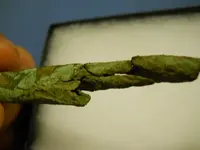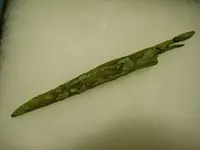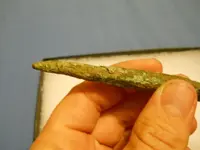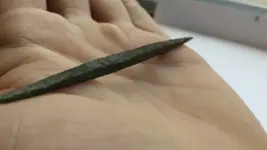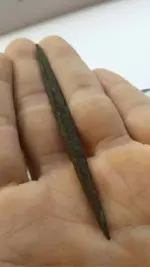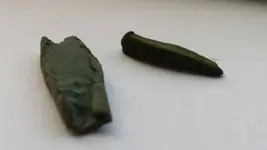You are using an out of date browser. It may not display this or other websites correctly.
You should upgrade or use an alternative browser.
You should upgrade or use an alternative browser.
Archaic Copper point
- Thread starter Glenn C
- Start date
Helix
Bronze Member
- Joined
- Jul 27, 2013
- Messages
- 1,425
- Reaction score
- 1,315
- Golden Thread
- 0
- Detector(s) used
- Garrett gti 2500, Whites DFX
- Primary Interest:
- All Treasure Hunting
Native copper is an uncombined form of copper which occurs as a natural mineral. Copper is one of the few metallic elements to occur in native form, although it most commonly occurs in oxidized states and mixed with other elements. Native copper was an important ore of copper in historic times and was used by pre-historic peoplesNative copper occurs rarely as isometric cubic and octahedral crystals, but more typically as irregular masses and fracture fillings. It has a reddish, orangish, and/or brownish color on fresh surfaces, but typically is weathered and coated with a green tarnish of copper(II) carbonate (also known as patina or verdigris). Its specific gravity is 8.9 and its hardness is 2.5–3.[SUP][[/SUP]
The mines of the Keweenaw native copper deposits of Upper Michigan were major copper producers in the 19th and early 20th centuries, and are the largest deposits of native copper in the world.[SUP][6][/SUP] Native Americans mined copper on a small scale at this and several other locations,[SUP][7][/SUP] and evidence exists of copper trading routes throughout North America among native peoples, proven by isotopic analysis. The first commercial mines in the Keweenaw Peninsula (which is nicknamed the "Copper Country" and "Copper Island"), opened in the 1840s. Isle Royale in western Lake Superior was also a site of many tons of native copper. Some of it was extracted by native peoples, but only one of several commercial attempts at mining turned a profit there
The name copper comes from the Greek kyprios, of Cyprus, the location of copper mines since pre-historic times
Trooper733
Sr. Member
- Joined
- Apr 3, 2013
- Messages
- 388
- Reaction score
- 315
- Golden Thread
- 0
- Location
- Eastern Oklahoma
- Detector(s) used
- Whites V3i,Whites DFX, Whites TRX, Garrett Pro Pointer
- Primary Interest:
- Other
There was a period of time when ancient weapons were made from copper found on the surface, before the technology was discovered to mine/smelt/work and alloy first copper and then iron in a forced air forge whereby copper was worked by hammering only because it was softer. Who is to say that early man in North America didn't make the same discovery made by early civilizations in Africa, Europe, etc. required to begin working Copper with impact tools without heat, which by the way, they found out at the same time caused the copper to become harder or more dense, making a weapon hold a point or edge better? The "Einstein" Native American that was way ahead of everyone else knapping rock points.? There are other parallel or similar discoveries by civilizations on different continents of like advances in technology. Wasn't the Clovis a revolution when it was discovered? And similar points have been found in France (hotly debated) as to whether it was transfer or unique separate production. Nice find Glenn C. Regardless of age, it is a rare find. Another point, (pun intended) at the time of the fur trade, iron trade points were already widely available and documentation exists of their being traded among the Native tribes, which to my opinion would preclude fur trade era, making it earlier by far as suggested by Glen. (Copper points by this time would be by then second fiddle, obsolete, unwanted) Just one mans opinion based on extensive reading and research of the fur trade (mountain man) era.
Last edited:
CRUSADER
Emerald Member
I have cleaned it further which still leaves me wondering. There are clear signs of the copper being hammerd. I have done my best to catch light on it to show the pecking and concave areas. Seems the darker patina is in the lower areas. This definitely has been pounded by a object.
If the piece was trade copper and flat there would be no reason to pound it flat? It has been ground on all side to make it sharp.
I honestly am at a loss for reasoning. The ground is alway disturbed in these areas..flipped several times frkm making homes etc. Could it be a archaic piece that was found in the soil while making a home. Lord knows i found points that way. Could it be possible it was refashioned with more modern techniques? Im not sure i just cannot get around the thickness.
A few picks and on with kettel metal.
AN ENGLISH BRONZE SKILLET | 17TH CENTURY | Private Collections & Country House Sales Auction | skillets, All other categories of objects | Christie's
Just had an idea. We find lots of small pieces of bronze (& other copper-alloy) pot fragments from 17th C & earlier skillets. This was an essential 17th C piece of kit used to cook all sorts. It thickness varies but I have had it as 'thin' & thinner than yours. If it broke on your side of the pond, it would need hammering & shaping because it had curves on it.
I think the only way to be sure is with expensive expert metalogical analysis that would point to the metal sources & a look under a strong microscope to see if the ground areas are wheel or stone done.
Like I said before if you can find an archie authority on these you could have a ground breaking piece which ever period it turns out to be.
Last edited:
CRUSADER
Emerald Member
There was a period of time when ancient weapons were made from copper found on the surface, before the technology was discovered to mine/smelt/work and alloy first copper and then iron in a forced air forge whereby copper was worked by hammering only because it was softer. Who is to say that early man in North America didn't make the same discovery made by early civilizations in Africa, Europe, etc. required to begin working Copper with impact tools without heat, which by the way, they found out at the same time caused the copper to become harder or more dense, making a weapon hold a point or edge better? The "Einstein" Native American that was way ahead of everyone else knapping rock points.? There are other parallel or similar discoveries by civilizations on different continents of like advances in technology. Wasn't the Clovis a revolution when it was discovered? And similar points have been found in France (hotly debated) as to whether it was transfer or unique separate production. Nice find Glenn C. Regardless of age, it is a rare find. Another point, (pun intended) at the time of the fur trade, iron trade points were already widely available and documentation exists of their being traded among the Native tribes, which to my opinion would preclude fur trade era, making it earlier by far as suggested by Glen. (Copper points by this time would be by then second fiddle, obsolete, unwanted) Just one mans opinion based on extensive reading and research of the fur trade (mountain man) era.
Interesting. This is why, if bridges are built with the Archies, we both have the full picture. This could be the missing piece of the jigsaw.
I think the only way to be sure is with expensive expert metalogical analysis that would point to the metal sources & a look under a strong microscope to see if the ground areas are wheel or stone done.
Like I said before if you can find an archie authority on these you could have a ground breaking piece which ever period it turns out to be.
Like I said in an earlier post Cru. Broker(scrap) businesses that handle the red metals also would have a spectrograph analyzer and it takes just seconds to find out what the base metal is, it takes maybe 15 seconds to give a complete analysis of all the metals contained in the item. The only reason I can say this is I've had thousands of pieces tested over the years while in the industry and back in the early 90's a sample had to melted into a button, then put into a large analyzer to be tested. Then came the testers that the item had to ground which would destroy the artifact, then there was the advancement where it only left a burn mark on the metal to ones that just could read the metal without any trace of damage to the surface.
CRUSADER
Emerald Member
Like I said in an earlier post Cru. Broker(scrap) businesses that handle the red metals also would have a spectrograph analyzer and it takes just seconds to find out what the base metal is, it takes maybe 15 seconds to give a complete analysis of all the metals contained in the item. The only reason I can say this is I've had thousands of pieces tested over the years while in the industry and back in the early 90's a sample had to melted into a button, then put into a large analyzer to be tested. Then came the testers that the item had to ground which would destroy the artifact, then there was the advancement where it only left a burn mark on the metal to ones that just could read the metal without any trace of damage to the surface.
I've heard of these, but would 'we' be able to interpret the results? Maybe, but I'm not experienced in that kind of science, are you saying you could help?
bill from lachine
Platinum Member
Trooper,
Some very valid facts that odds are copper points would have been considered obsolete post contact period due to the availability of iron points.....most of the kettle metal pieces were used to fabricate decorative items such as tinkler cones, etc...
Also natives would repurpose barrel bands to make arrow heads, knife blades, etc.....I seem to recall.
Regards + HH
Bill
Some very valid facts that odds are copper points would have been considered obsolete post contact period due to the availability of iron points.....most of the kettle metal pieces were used to fabricate decorative items such as tinkler cones, etc...
Also natives would repurpose barrel bands to make arrow heads, knife blades, etc.....I seem to recall.
Regards + HH
Bill
There was a period of time when ancient weapons were made from copper found on the surface, before the technology was discovered to mine/smelt/work and alloy first copper and then iron in a forced air forge whereby copper was worked by hammering only because it was softer. Who is to say that early man in North America didn't make the same discovery made by early civilizations in Africa, Europe, etc. required to begin working Copper with impact tools without heat, which by the way, they found out at the same time caused the copper to become harder or more dense, making a weapon hold a point or edge better? The "Einstein" Native American that was way ahead of everyone else knapping rock points.? There are other parallel or similar discoveries by civilizations on different continents of like advances in technology. Wasn't the Clovis a revolution when it was discovered? And similar points have been found in France (hotly debated) as to whether it was transfer or unique separate production. Nice find Glenn C. Regardless of age, it is a rare find. Another point, (pun intended) at the time of the fur trade, iron trade points were already widely available and documentation exists of their being traded among the Native tribes, which to my opinion would preclude fur trade era, making it earlier by far as suggested by Glen. (Copper points by this time would be by then second fiddle, obsolete, unwanted) Just one mans opinion based on extensive reading and research of the fur trade (mountain man) era.
- Joined
- Jan 27, 2009
- Messages
- 18,871
- Reaction score
- 12,120
- Golden Thread
- 1
- Location
- South East Tennessee on Ga, Ala line
- 🥇 Banner finds
- 1
- Detector(s) used
- Tesoro Conquistador freq shift
Fisher F75
Garrett AT-Pro
Garet carrot
Neodymium magnets
5' Probe
- Primary Interest:
- All Treasure Hunting
What do people not understand about the copper culture era here? It is as well known as in the Northern states and Canada as colonial and recognized for its rareness over anything common like woodland,Mississippian,Archaic or what ever because it was specific to a region that had the raw mineral. If it does not fall into that time frame it could be trade era.
The only question is it trade era or copper culture?
Also everyone stop the badgering and we can learn as we go. Sounds like a cross examination in here!
The only question is it trade era or copper culture?
Also everyone stop the badgering and we can learn as we go. Sounds like a cross examination in here!
bill from lachine
Platinum Member
TNMountains,
Ive known Glenn for quite a few years now and he knows his stuff both from research and he learned quite a lot from a fellow detectorist who lives in the Upper Peninsula of Wisconsin in the heart of Archaic copper country....the guy has found hundreds of pieces as well as loads of float copper which was one of the main sources of raw copper for processing.
So Ill take his word for it when he states his finds are archaic.
Regards + HH
Bill
Ive known Glenn for quite a few years now and he knows his stuff both from research and he learned quite a lot from a fellow detectorist who lives in the Upper Peninsula of Wisconsin in the heart of Archaic copper country....the guy has found hundreds of pieces as well as loads of float copper which was one of the main sources of raw copper for processing.
So Ill take his word for it when he states his finds are archaic.
Regards + HH
Bill
CRUSADER
Emerald Member
What do people not understand about the copper culture era here? It is as well known as in the Northern states and Canada as colonial and recognized for its rareness over anything common like woodland,Mississippian,Archaic or what ever because it was specific to a region that had the raw mineral. If it does not fall into that time frame it could be trade era.
The only question is it trade era or copper culture?
Also everyone stop the badgering and we can learn as we go. Sounds like a cross examination in here!
So, what is your opinion? Simple? (because you seem to suggest I'm missing the point)
PS. I'm trying to learn the point & don't understand yours. Explain?
Last edited:
OWK
Hero Member
- Joined
- Apr 26, 2014
- Messages
- 998
- Reaction score
- 1,292
- Golden Thread
- 0
- Location
- North Central Md
- Detector(s) used
- Fisher F70, F75
Garrett Pinpointer
- Primary Interest:
- All Treasure Hunting
So, what is your opinion? Simple? (because you seem to suggest I'm missing the point)
PS. I'm trying to learn the point & don't understand yours. Explain?
Easy there, my friend.
I don't even think the comment was pointed at you.
CRUSADER
Emerald Member
Easy there, my friend.
I don't even think the comment was pointed at you.
Sorry, my mistake, maybe this post has made me over sensitive.
OWK
Hero Member
- Joined
- Apr 26, 2014
- Messages
- 998
- Reaction score
- 1,292
- Golden Thread
- 0
- Location
- North Central Md
- Detector(s) used
- Fisher F70, F75
Garrett Pinpointer
- Primary Interest:
- All Treasure Hunting
Sorry, my mistake, maybe this post has made me over sensitive.
I think this whole thread has been a little sensitive from the beginning.
It's unfortunate really...
An interesting artifact. And some good discussion from people whose opinions I value.
Hopeful that's all winding down now, and we can get back to the point (pun intended).

CRUSADER
Emerald Member
I think this whole thread has been a little sensitive from the beginning.
It's unfortunate really...
An interesting artifact. And some good discussion from people whose opinions I value.
Hopeful that's all winding down now, and we can get back to the point (pun intended).
Yes but what is the point....

- Joined
- Jan 27, 2009
- Messages
- 18,871
- Reaction score
- 12,120
- Golden Thread
- 1
- Location
- South East Tennessee on Ga, Ala line
- 🥇 Banner finds
- 1
- Detector(s) used
- Tesoro Conquistador freq shift
Fisher F75
Garrett AT-Pro
Garet carrot
Neodymium magnets
5' Probe
- Primary Interest:
- All Treasure Hunting
So, what is your opinion? Simple? (because you seem to suggest I'm missing the point)
PS. I'm trying to learn the point & don't understand yours. Explain?
To the point.I guess the inbox of post complaints about the line of questioning brought me here.
To me it appears where the natives tried to fashion their familiar tools out of settlers material.I also agree he is more knowledgable than I because he specifically hunts that era.
I wonder if he could look at the bevel cut on the point with a microscope or jewelers loop and if filled at an angle a file was used and that answers the question. The bevel was a new technology in the archaic period in stone tools
I have not seen copper culture points so thick. Most time it is hammered out and rolled being from float copper
oxbowbarefoot
Banned
Glenn C
Sr. Member
- #97
Thread Owner
To the point.I guess the inbox of post complaints about the line of questioning brought me here.
To me it appears where the natives tried to fashion their familiar tools out of settlers material.I also agree he is more knowledgable than I because he specifically hunts that era.
I wonder if he could look at the bevel cut on the point with a microscope or jewelers loop and if filled at an angle a file was used and that answers the question. The bevel was a new technology in the archaic period in stone tools
I have not seen copper culture points so thick. Most time it is hammered out and rolled being from float copper
Thanks for info. I believe it is beveled. There is a line along the bottom area as if it was beveled. If not that line on each side would be filed away. As well as the notches in the corners. So bevel makes sense.
Im adding a picture of awl. This is the first piece i found and cleaned it due to a simular situation to prove it. Regardless... you can see how square the maker was able to make this which no fold are anywhere and it is twice as thick at the center than the point. Almost unbelievable as well. This piece is from 30 feet away. Also a few piece uncleaned from the area.
I will bring it to a museum and talk to the staff and see if anyone has any knowledge in that area. Even in the know its hard to know, I believe.
I would love to see a article pertaining to the bevel process which i have not come across yet.
Cheers
Attachments
Trooper733
Sr. Member
- Joined
- Apr 3, 2013
- Messages
- 388
- Reaction score
- 315
- Golden Thread
- 0
- Location
- Eastern Oklahoma
- Detector(s) used
- Whites V3i,Whites DFX, Whites TRX, Garrett Pro Pointer
- Primary Interest:
- Other
Keep us updated Glenn C. I am, and Im sure others are, interested to learn the consensus. Again, cool find.
bill from lachine
Platinum Member
Glenn,
Good luck with checking with the museum personnel....as you probably know there's a limited number of qualified professionals both in museums and universities who can evaluate archaic copper culture artifacts.
As mentioned by others keep us posted what you find out.
Regards + HH
Bill
Good luck with checking with the museum personnel....as you probably know there's a limited number of qualified professionals both in museums and universities who can evaluate archaic copper culture artifacts.
As mentioned by others keep us posted what you find out.
Regards + HH
Bill
Thanks for info. I believe it is beveled. There is a line along the bottom area as if it was beveled. If not that line on each side would be filed away. As well as the notches in the corners. So bevel makes sense.
Im adding a picture of awl. This is the first piece i found and cleaned it due to a simular situation to prove it. Regardless... you can see how square the maker was able to make this which no fold are anywhere and it is twice as thick at the center than the point. Almost unbelievable as well. This piece is from 30 feet away. Also a few piece uncleaned from the area.
I will bring it to a museum and talk to the staff and see if anyone has any knowledge in that area. Even in the know its hard to know, I believe.
I would love to see a article pertaining to the bevel process which i have not come across yet.
Cheers
Similar threads
D
- Replies
- 13
- Views
- 748
- Replies
- 10
- Views
- 1K
Users who are viewing this thread
Total: 1 (members: 0, guests: 1)




